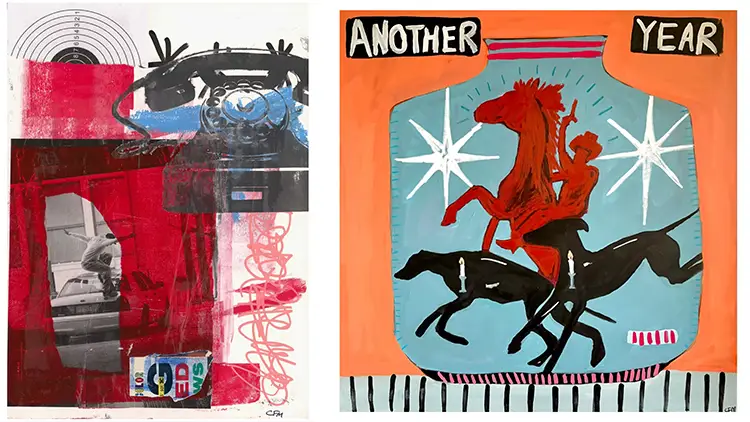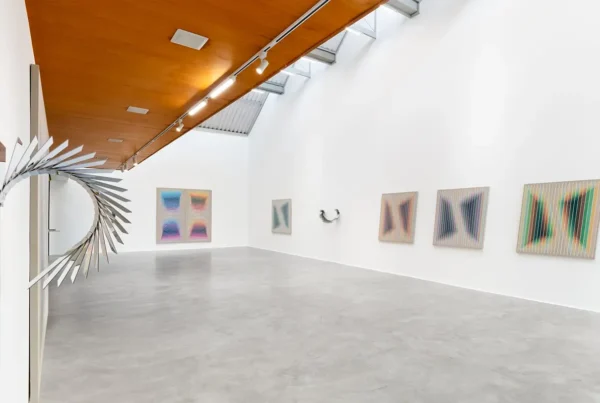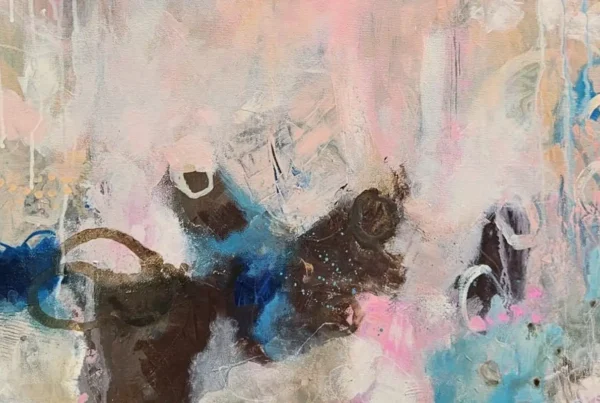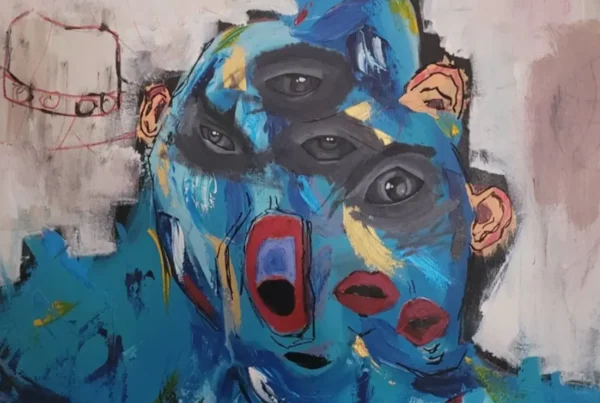Art as Afterimage: The Emotional Architecture of Flood-Molyneux’s Practice
Caitlin Flood-Molyneux, a contemporary artist based in South Wales, brings a raw, emotionally resonant edge to the world of mixed media and abstraction. Their body of work, recognized both in the UK and internationally, transcends traditional boundaries by forging unexpected connections between popular culture and personal memory. Drawing from the influence of DADA and early Pop Art, Flood-Molyneux channels a vibrant aesthetic into layered narratives that explore the complexity of lived experience. Their artistic philosophy centers around the belief that images—especially those familiar from mass culture—serve as vessels for memory, capable of triggering deeply personal reflections even in a public context. This vision has earned them recognition in significant cultural spaces, including exhibitions at Christie’s and Sotheby’s, and a place on the Forbes 30 shortlist in 2024.
Flood-Molyneux’s work is as much about internal landscapes as it is about external stimuli. At its core, their practice seeks to unpack how individuals, especially those navigating adversity, emotionally engage with the media they consume. Using found imagery from sources like comic books, 1970s advertisements, and retro film posters, they create intricate collages that serve as both emotional catalysts and narrative foundations. These recontextualized visuals, once divorced from their original meanings, become charged symbols of memory and introspection when layered with expressive paint gestures. For Flood-Molyneux, destruction is a creative act: defacing, obscuring, and transforming these images enables the emergence of a new, more personal visual dialogue that reflects their subjective experiences of grief, anger, love, and resilience.
This reflective and visceral approach to image-making is not just an artistic strategy but a deeply personal mode of storytelling. Flood-Molyneux likens the experience of viewing their work to hearing a nostalgic song—initially faint, then suddenly overwhelming in its emotional clarity. These compositions do not offer linear narratives; instead, they operate like emotional flashpoints, pulling the viewer into an ambiguous yet intimate exchange. Through layers of paint and meaning, Flood-Molyneux invites each individual to bring their own history to the work, transforming the artwork into a shared space of recollection. Their visual language is simultaneously enigmatic and accessible, insisting on introspection while allowing room for collective connection.
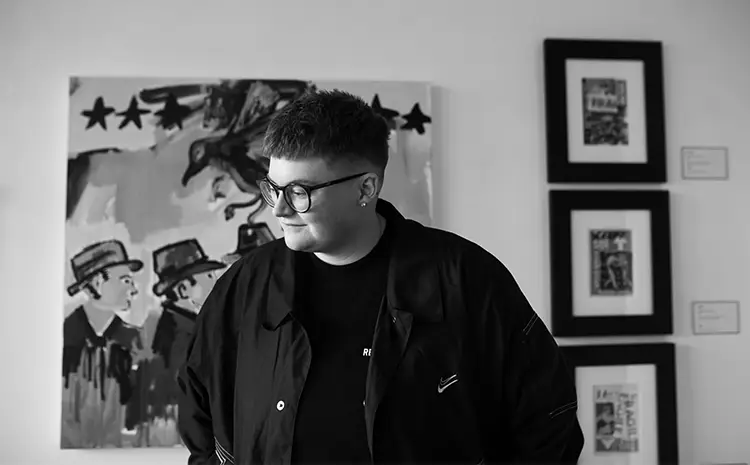
Caitlin Flood-Molyneux: Collage as Catalyst, Gesture as Release
The materials Caitlin Flood-Molyneux employs are not just tools but storytellers in their own right. Their process begins with the physical act of cutting and collaging images—fragments that once held cultural significance but are now repurposed as emotional signposts. These materials, often drawn from decades-old media, carry with them a sense of familiarity that resonates on a subconscious level. Once arranged, these collaged scenes undergo radical transformation through layers of paint, including oil and aerosol. This fusion of precise composition and chaotic intervention becomes a physical metaphor for emotional unearthing, where structured memories are disrupted and reshaped through cathartic gestures.
The interplay between structure and spontaneity is crucial to Flood-Molyneux’s visual lexicon. By embracing the tension between the orderly and the chaotic, they craft works that are emotionally intricate and visually arresting. In many cases, their painted responses to the collaged imagery are driven by intuitive mark-making, allowing unspoken feelings to dictate color choices, brushwork, and spatial arrangements. This dialogue between found image and painterly overlay serves as both confrontation and reconciliation—mirroring how memories are often revisited, reframed, or even resisted over time. The artwork becomes not only an external representation of memory but also a space for personal healing and transformation.
One such example is their painting Ambush, a pivotal work from their 2023 solo show in London. Later exhibited at Christie’s as part of the Christie’s Lates Pride event, the piece holds particular significance for Flood-Molyneux. They regard it as a marker of personal and artistic progression, representing the culmination of years spent refining their visual voice. Ambush is more than a standout composition; it encapsulates their belief that art should challenge conventions, confront discomfort, and affirm the evolving nature of identity. For Flood-Molyneux, this painting is not just a favorite—it’s a symbol of how far they’ve come and how much further they intend to go.
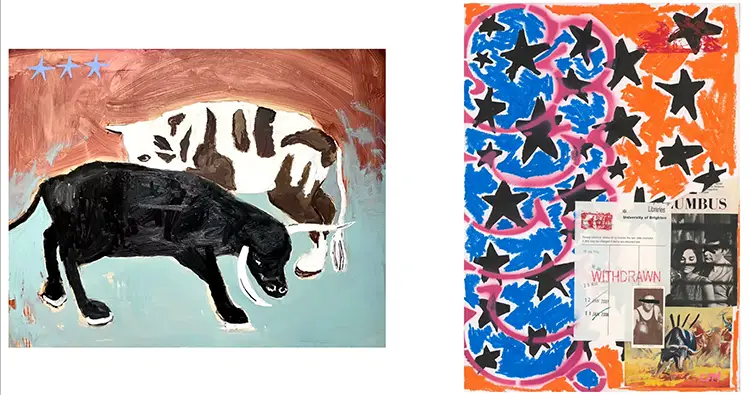
Memory in Motion: Constructing Emotion Through Cultural Debris
In Caitlin Flood-Molyneux’s studio, time doesn’t move in a straight line—it loops, overlaps, and rewinds through a visual symphony of repurposed cultural material. Their ongoing exploration of memory is built on the idea that images, much like music or scent, can act as emotional triggers. By using pop cultural fragments from bygone eras, Flood-Molyneux leverages the power of collective nostalgia to anchor deeply personal narratives. These chosen visuals are not passive inclusions; they are deliberate provocations, positioned to elicit feelings that words often fail to capture. The layering of meaning within each piece transforms the artwork into a kind of visual diary—open to interpretation yet firmly grounded in emotional truth.
The process by which they convert these images into meaningful art involves an intense emotional commitment. Flood-Molyneux describes artmaking as a reflective experience—one that allows them to channel a wide spectrum of emotions, from the ache of grief to the serenity of love. This depth of feeling is evident in their dynamic use of color and texture, where brash reds, delicate pastels, and ghostly silhouettes coexist. Each painted layer acts as a form of emotional punctuation, intensifying or subduing the tone of the composition. The result is a practice that is not only visually compelling but psychologically immersive, pulling the viewer into a shared meditation on time, memory, and identity.
What sets Flood-Molyneux’s work apart is its ability to balance personal narrative with broader cultural commentary. While the scenes are drawn from individual experience, they resist solipsism by inviting the audience to bring their own context to the imagery. Flood-Molyneux’s pieces are built not just to be viewed but to be felt—they function as open invitations for emotional projection. By marrying personal symbolism with recognizable cultural motifs, they create a space where the viewer’s past can intersect with the artist’s in profound, unexpected ways. Their practice not only redefines how we perceive image-based art but also reframes the emotional potential of visual memory.
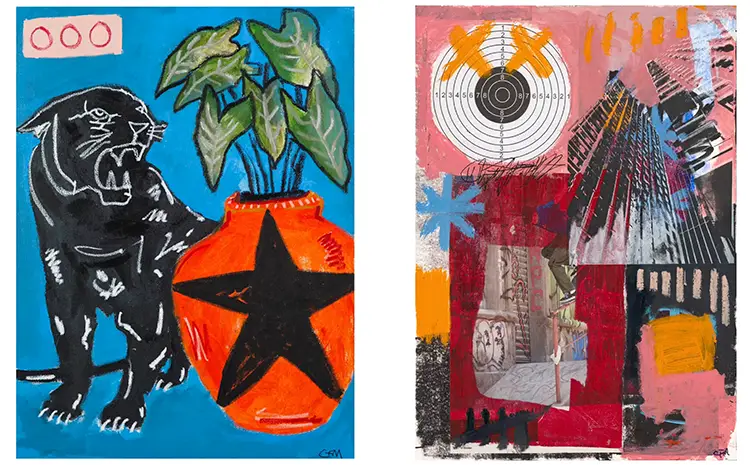
Caitlin Flood-Molyneux: Reshaping Possibility Through Art and Identity
Caitlin Flood-Molyneux’s commitment to art goes beyond aesthetics—it’s a statement of possibility and persistence. They frequently speak about how creativity became a sanctuary, especially after coming out, turning art into a space for personal affirmation and resistance. Coming from a working-class background without institutional advantages, Flood-Molyneux actively resists the myth that becoming a successful artist is reserved for a privileged few. Their career, marked by international exhibitions in cities like London, New York, Venice, and Tokyo, stands as a testament to what determination and authenticity can accomplish in a notoriously exclusive industry.
In interviews, Flood-Molyneux often addresses the societal perception of artists as outliers or dreamers. Their perspective is refreshingly grounded: artistry, they argue, is neither luxury nor fantasy, but a vocation fueled by vision and resilience. Their own trajectory—beginning with painting alongside their mother as a child, through formal training at art college at sixteen, to global recognition—embodies the very ideal they hope to promote. When asked what they’d most like to reinvent in the world, their response is unequivocal: they would change the idea that a creative life is unattainable. For Flood-Molyneux, representation and access are essential, and their work continually challenges elitist structures by foregrounding vulnerability, joy, and struggle.
The influences that shape their practice extend beyond technique into ethos. One of their enduring inspirations is painter Gillian Ayres, whose fearless use of color and intuitive process left a lasting impression. Flood-Molyneux sees in Ayres not only a model for artistic courage but a reflection of their own drive to create boldly and unapologetically. This admiration underscores their belief in the value of play, risk, and experimentation within art. Their journey is a narrative of self-definition, where creativity operates both as a personal refuge and a political stance. Through their vivid compositions and unwavering authenticity, Caitlin Flood-Molyneux offers a vision of contemporary art that is inclusive, emotionally resonant, and defiantly human.
